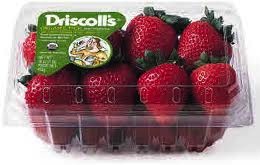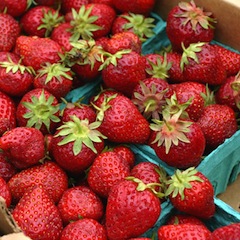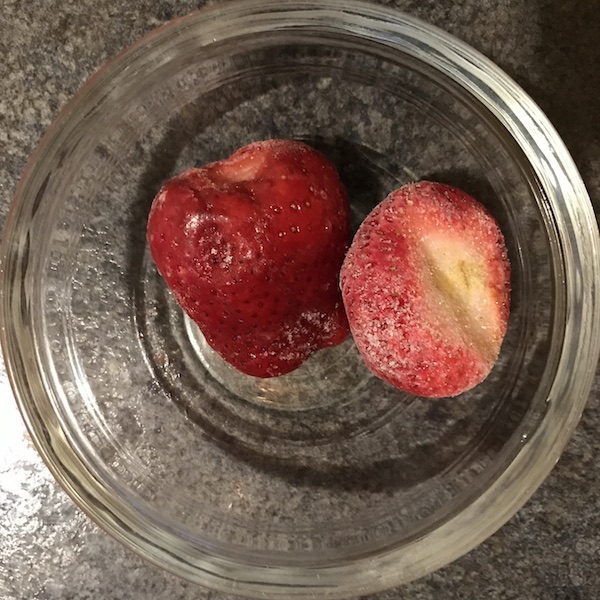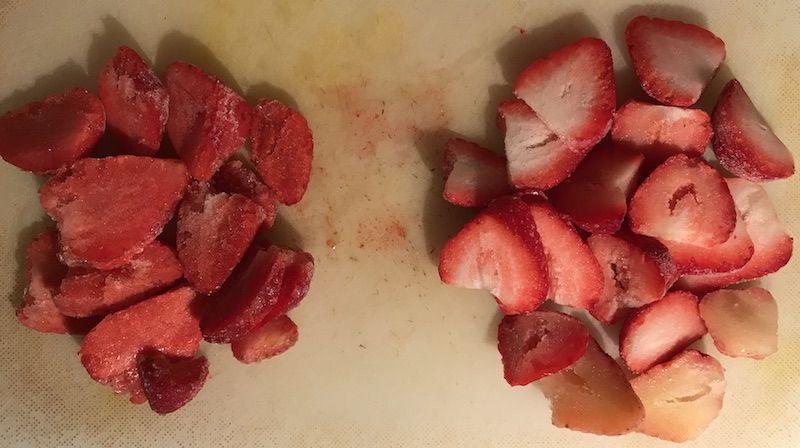Audio Interlude
Strawberries that in gardens grow
Are plump and juicy fine,
But sweeter far as wise men know
Spring from the woodland vine.
No need for bowl or silver spoon,
Sugar or spice or cream,
Has the wild berry plucked in June
Beside the trickling stream.
One such to melt at the tongue’s root,
Confounding taste with scent,
Beats a full peck of garden fruit:
Which points my argument.
Robert Graves
Does your strawberry taste as good as it looks?
Strawberries are my absolute favorite fruit, and I look forward to strawberry season every year. Depending on where you live that season can start as early as mid-June or as late as mid-July. This year we bought our last quart of berries at the farmers market the second week of August. They were amazing!
 Every year or so, when the first California berries make their appearance, we’re seduced into buying one – just one – box of strawberries at the supermarket. They always look so beautiful: large berries, bright red, the leaves still attached and fresh…
Every year or so, when the first California berries make their appearance, we’re seduced into buying one – just one – box of strawberries at the supermarket. They always look so beautiful: large berries, bright red, the leaves still attached and fresh…
I imagine all kinds of wonderful treats made with them but first I just want to slice them up with a little honey and have them with yogurt.
Silly me!
Open the plastic clamshell that displays those berries in all their voluptuousness; like Botticelli’s Venus on the seashell. Hold that little beauty in your palm – OK, stop salivating! Make that first slice right through the center…
Oops… when did ripe strawberries have white centers? Where’s that wonderful strawberry smell? And the taste? Cardboard has more taste!
BTW, think that you can get around this problem by buying frozen berries? Think again! Compare these frozen organic berries from two commercial growers: Stalbush Island Farms and Cascadian Farms.
Stalbush still grows strawberries with flavor; the Cascadian berries tasted like water. Better though, than the last bag of Woodstock frozen organic strawberries we bought, which came all the way from Turkey! No thanks, I don’t want world-traveling berries.
Berries on the left of each photo are from Stalbush Island Farms, those on the right are from Cascadian Farms.
A little history

Major commercial strawberry production in California began in the early 1850s but did not expand until around 1900, when refrigerated railroad cars enabled growers to transport the berries over long distances.
Today strawberries are grown on more than 45,000 acres and the US is the world’s top producer of strawberries. And it’s the refrigeration that makes it possible for us to have strawberries almost year ’round.(1)
Driscoll’s, a fourth-generation family business, says that it controls roughly a third of the six-billion-dollar U.S. berry market, including sixty per cent of organic strawberries, forty-six per cent of blackberries, fourteen per cent of blueberries, and just about every raspberry you don’t pick yourself.
The company develops proprietary breeds, licenses them exclusively to approved Driscoll’s growers, and sells the fruit under one of the few widely recognizable brand names in the fresh section of the grocery store.(2)
The ideal Driscoll berry is bigger than a toddler’s fist, deep bright read, broad-shouldered with a nicely pointed tip, sturdy enough to travel anywhere in the world, and still be edible two weeks after they’ve been picked.
Now read that again carefully – does it say any where that the idea strawberry should taste like a strawberry? Nope…
Better fruit through chemistry?
Weeds, insect pests, and disease can make commercial production of strawberries challenging; to prevent crop loss growers apply a variety of pesticides: herbicides, insecticides, and fungicides.
Strawberries are irresistible to pests, especially soil-borne pathogens. Most pesticide comes before the crop is even planted in the form of soil fumigants. The two most common are 1,3-Dichloropropene (1,3-D) and chloropicrin, both of which are banned in the EU.(3)
It’s that use of pesticides that gives strawberries the #3 post on the Environmental Working Group’s Dirty Dozen list of fruits and vegetables. As many as 13 different pesticides were detected on a single sample of strawberries.
Even with all the pressure from conventional growers and the pesticide industry, it’s clear that organic is not only “as good as” conventionally grown, but is better over all. Research from Washington State University compared side by side plots of organic and conventional strawberries in California. The results:
- Organic strawberries had more dry matter, or, “more strawberry in the strawberry.”
- Organic strawberries had significantly higher antioxidant activity and concentrations of ascorbic acid and phenolic compounds.
- Organic strawberries had longer shelf life.
- The organic soils excelled in a variety of key chemical and biological properties, including carbon sequestration, nitrogen, microbial biomass, enzyme activities, and micronutrients.
- The organically managed soils had dramatically more total and unique genes and greater genetic diversity, important measures of the soil’s resilience to stress and ability to carry out essential processes.
Buy organic and buy local
So where do you get fresh strawberries with flavor? Buy organic and buy local. Head out to your local farmers market and run – don’t walk – to the nearest berry vendor and buy organic or transitional berries.
They may not be “perfect,” some may be larger, some smaller, and occasionally even lumpy, but they are definitely REAL strawberries! And there’s nothing more heavenly than fresh ripe strawberries picked just hours before you buy them!
(1) Fruit and soil quality of organic and conventional strawberry agroecosystems, University of Washington, September 2010
(2) How Driscoll’s Reinvented the Strawberry, Dana Goodyear, The New Yorker, August 21, 2017 issue.
Photo credits:
Blooming wild strawberries – Daria Markova/Flickr
Large strawberry photo – Daveob/Flickr


